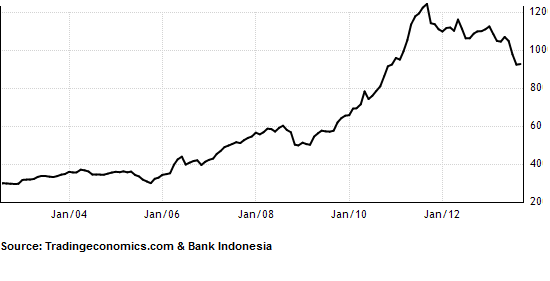Indonesia's Foreign Exchange Reserves Grow Slightly in August 2013
 For the first time since April 2013, Indonesia's foreign exchange reserves have shown a small growth. Indonesia's central bank (Bank Indonesia) stated that in late August, the foreign exchange reserves rose to USD $92.99 billion from USD $92.67 billion a month earlier. The growth was a surprise as continued capital outflows from Indonesia's financial markets was expected to translate into lower reserves. Last week, Indonesia's benchmark stock index fell 2.97 percent, while the rupiah fell 2.55 percent against the US dollar.
For the first time since April 2013, Indonesia's foreign exchange reserves have shown a small growth. Indonesia's central bank (Bank Indonesia) stated that in late August, the foreign exchange reserves rose to USD $92.99 billion from USD $92.67 billion a month earlier. The growth was a surprise as continued capital outflows from Indonesia's financial markets was expected to translate into lower reserves. Last week, Indonesia's benchmark stock index fell 2.97 percent, while the rupiah fell 2.55 percent against the US dollar.
However, despite the weakening stock index and currency, the central bank detected an increase of foreign funds in Bank Indonesia Certificates (SBIs). SBIs are the central bank's main tool for open market operations, and are issued to control liquidity in the banking system (with 1 and 3-month rupiah denominated tenors). This explains the higher foreign reserves in August 2013.
The country's foreign exchange reserves hit a peak of USD $116.4 billion in April 2012 and another peak of USD $112.78 billion in December 2012. From January 2013, however, the reserves have been on a weakening trend, partly because the central bank used its reserves to support the falling rupiah. Indonesia's currency has fallen 15.8 percent since 1 January 2013 based on the central bank's mid rate. Starting in June 2013, the rupiah began depreciating sharply due to global concerns about an end to the Federal Reserve's quantitative easing program as well as Indonesia's widening current account deficit.
The country's current amount of foreign exchange reserves are equivalent to 5.2 months of import and foreign debt payment.
Indonesia Foreign Exchange Reserves 2002-2013 (in USD billion)

Bahas
Silakan login atau berlangganan untuk mengomentari kolom ini
